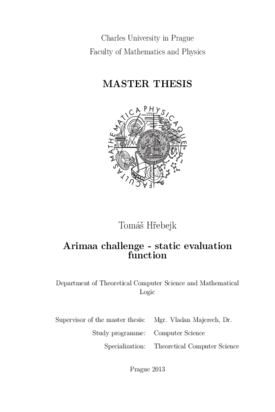Arimaa challenge - static evaluation function
Arimaa challenge - statistická ohodnovací funce
diplomová práce (OBHÁJENO)

Zobrazit/
Trvalý odkaz
http://hdl.handle.net/20.500.11956/53723Identifikátory
SIS: 82277
Katalog UK: 990016773380106986
Kolekce
- Kvalifikační práce [11978]
Autor
Vedoucí práce
Oponent práce
Baudiš, Petr
Fakulta / součást
Matematicko-fyzikální fakulta
Obor
Teoretická informatika
Katedra / ústav / klinika
Katedra teoretické informatiky a matematické logiky
Datum obhajoby
21. 1. 2014
Nakladatel
Univerzita Karlova, Matematicko-fyzikální fakultaJazyk
Angličtina
Známka
Výborně
Klíčová slova (česky)
Arimaa, umělá inteligence, strojové učení, paralelizaceKlíčová slova (anglicky)
Arimaa, artificial intelligence, machine learning, parallelizationArimaa je strategická desková hra pro dva hráče. Byla navržena tak, aby nebylo nebylo jednoduché vytvořit počítačový program, který by dokázal porazit nejlepší lidské hráče. V této práci jsme se zaměřili na návrh statické ohodnocovací funkce pro hru Arimaa. Úkolem ohodnocovací funkce je určit, který hráč má v dané pozici výhodu a jak je velká. Tento problém jsme rozdělili do několika částí, které jsme řešili samostatně. Nejvíce jsme se věnovali efektivnímu rozpoznávání významných vzorů na desce, například gólovým hrozbám. Základním prvkem navržené ohodnocovací funkce je mobilita. Pro každou figurku odhadneme počet kroků potřebný k tomu, aby se tato figurka přesunula na ostatní místa herní desky. Dále jsme se zabývali strojovým učením. Navrhli jsme nový algoritmus pro učení ohodnocovací funkce podle her expertů. Součástí práce je i implementace herního programu, který demonstruje navržené metody. Powered by TCPDF (www.tcpdf.org)
Arimaa is a strategic board game for two players. It was designed with the aim that it will be hard to create a computer program that could defeat the best human players. In this thesis, we focus on the design of the static evaluation function for Arimaa. The purpose of a static evaluation function is to determine which player is leading in a given position and how significant the lead is. We have divided the problem into a few parts, which were solved separately. We paid most attention to the efficient recognition of important patterns on the board, such as goal threats. The basic element of the proposed evaluation function is mobility. For each piece, the number of steps that the piece would need to get to other places on the board is estimated. We also examined machine learning. We developed a new algorithm for learning a static evaluation function from expert games. An implementation of an Arimaa playing program, which demonstrates the proposed methods, is part of the thesis. Powered by TCPDF (www.tcpdf.org)
